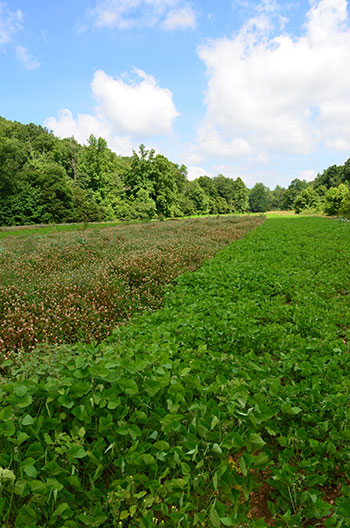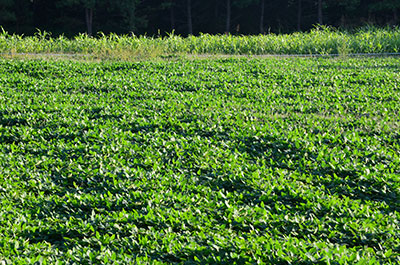LAST UPDATED: May 1st, 2015
CP Lablab strips
Plot partitioning…that’s a mouthful of vowels that simply means keeping crops separate. With the increasing number of hunters planting food plots for wildlife, the need for some of us competitive minded folks to take farming for wildlife to another level has also risen. The days of just simply tossing a bag of grain bin floor sweepings out on plowed up field are over. With all of the research that has taken place over the last 15-20 years on the importance nutrition plays in the quest for healthier and bigger deer, gamekeepers have a lot of resources at their disposal to know what, when, where, why, and how to grow crops that are going to benefit their deer herd and other wildlife.

One question that I get asked quite often is “what should I plant to keep deer in my plots for the entire hunting season”? Regardless of where you live, just one planting would have a hard time being everything your deer herd needs for the early, mid, and late hunting season. Plot partitioning can really help in providing an attractive and nutritious food source throughout the changes that take place from September to January. This point is even further evident with some states starting their whitetail season as early as August and going into February. So let’s say we have a 5 acre field somewhere in the north or midwest that we want to be a hunting mecca from early to late season. Ideally I would utilize 3-4 different plantings to help achieve that task. To begin this project we would need to start off in the early spring by prepping 1 acre of the plot to be spring planted with a perennial clover blend. This perennial portion of the plot would spend the spring and summer establishing a solid root system and by late summer would be a really attractive plot that should provide good forage for the early part of the deer season. Keep in mind you would need to manage the perennial properly through the warm months to ensure its success.
Beans & Blind Spot
The next planting step is one that can really help set your plot apart from the average as well as increasing its feeling of security by your deer. In the late spring/early summer plant the perimeter of the field in a tall growing annual that will screen the plot and provide a good transition zone from woods or thickets to the plot. This perimeter screen only has to be 1-2 tractor widths wide to achieve its purpose. Blind Spot is a great seed blend for this screen effect that can easily grow 7-12 ft in height. I also like to use a strip of Blind Spot to partition portions of the field. This achieves a couple of goals, 1) the deer feel safer because from their point of view the field appears smaller and 2) it keeps your plantings separate and adds to the diversity of the field. Using a tall screen to partition off your plantings can be done in any direction or design that fits the shape of your field. Blind Spot can also be used as a great way to hide your approach into different stands you have around the field. Not only does it make a great way to hide your entrance but you can also use Blind Spot to hide the view of plots from roads or nosy neighbors that may be able to see your plots.

So now we are in the late summer and it’s time to start preparing the rest of the field into cool season annuals. In addition to the perennials, we need to create some more early and mid season forage. Over the last couple of years, my go to combination for this is a mix of oats and Deer Radish. These two crops are great companions and are extremely attractive during that September-November time period. Of the 4 acres we have remaining available to plant in this scenario, I would plant two of them in this oats and radish combo. Depending on what state you are planting in, this is a mid-late August planting for the middle of the country.
So we have two acres remaining to plant and we are thinking about the late season. This December-February part of the year can be taxing on a whitetail’s body. Bucks are chasing does and fighting, does are constantly running from bucks, and they are all on high alert by this time of year from all different forms of hunters tromping through the woods. A reliable late season food source can be the difference maker in filling your tag with a good mature buck. This is where I rely on the brassica family of plants, Maximum and Winter Bulbs in particular. These two blends are similar in that they are both 100% brassica blends, Maximum is heavier in forage production, where as Winter Bulbs & Sugar Beets is heavier in bulb production. So with the two acres left, I would plant 1 acre each in these two blends to create a lot of late season attraction and nutrition to the field.
One more option that you can look into when separating or partitioning plots is the use of soft or hard mast producing trees. Depending on the species of trees planted and where you live, you can add early or late season appeal to your plot with mast producing trees that drop their acorns or fruit at key times of the season. Instead of planting the trees in typical orchard fashion, they can be planted in wide spaced rows that allow for easier viewing and are not so close that you can’t maneuver around them with tractors and implements. When planted wide enough, some guys even use the area in between their tree rows to plant different food plot crops.
These are all options to use when partitioning crops, there is no right or wrong way to do it. The main idea is to take an area and use several crops and plants to increase the diversity of your land and provide your deer security and season long food choices. Different parts of the county will require slightly different timing on the planting of these crops, check out the GameKeepers website for ideal planting times for the part of the country where you plant.





